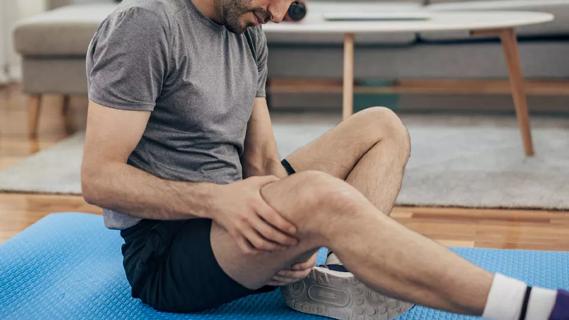Lifestyle adjustments can provide big relief

Doctors aren’t entirely sure what causes myofascial pain syndrome, although inflammation tops the list of culprits. But whatever the cause, myofascial pain hurts. Bad. And you want relief.
Advertisement
Cleveland Clinic is a non-profit academic medical center. Advertising on our site helps support our mission. We do not endorse non-Cleveland Clinic products or services. Policy
“Myofascial pain syndrome is pain related to the fascia, the connective tissue covering the muscles,” explains pain medicine doctor George Girgis, DO.
There is no single treatment for this condition. However, because inflammation is likely the root cause of myofascial pain, lifestyle adjustments can be effective at providing relief.
Dr. Girgis says the first step is to see a pain specialist to rule out an underlying problem, like arthritis or fibromyalgia. If your doctor rules out those conditions and believes myofascial pain syndrome is to blame, these eight adjustments may help. Talk to your doctor about making these changes:
Go to the Mediterranean (diet). Switch to an anti-inflammatory diet, like the Mediterranean diet (lots of fruits, vegetables, whole grains and fish). This approach to eating increases antioxidants and decreases the unhealthy carbohydrates that promote inflammation.
Get moving. You don’t need strenuous exercise; you simply need to move. When your muscles are inactive, they become deconditioned, which leads to muscle loss and inflammation.
“Exercise has the added benefit of increasing endorphins and enkephalins,” says Dr. Girgis. “These are happy hormones that can help overcome the stress of living with chronic pain.”
Swimming is a great exercise choice for people with myofascial pain. It’s no-impact and works all your muscle groups.
Log enough pillow time. Pain and sleep are closely related. Getting enough high-quality sleep can help minimize the pain you feel during the day. Try to go to sleep at the same time every day and limit screen time right before bed.
Advertisement
Get more vitamin D. Muscles and bones need vitamin D to stay healthy, but it can be challenging to get enough through diet alone. Sunshine is another key source of vitamin D, so try to spend a few minutes outside each day. And speak to your doctor about choosing a supplement or foods that have added vitamin D.
Achieve a healthy weight. Obesity puts pressure on your joints, causing pain and making you less likely to exercise. The less you move, the more muscle pain you’ll have. It’s a vicious cycle. Talk to your doctor or nutritionist about how you can lose any extra weight, safely.
Don’t slouch! If you sit in front of a computer, you’re likely slouching, which can lead to stiffness and muscle pain. “Sit straight and invest in a good-quality lumbar support roll to maintain the lumbar curve in your back,” says Dr. Girgis. “Raise your phone to the level of your head, rather than looking down to view it.”
Maintain muscle mass. Maintaining muscle helps avoid the deconditioning cycle that leads to inflammation. But you don’t need to be a bodybuilder or even buy a gym membership. Find easy ways to challenge your muscles, such as doing a plank or squat exercises.
Keep calm and manage stress. Stress causes muscle aches and fatigue, which can negatively impact exercise and sleep. Yoga and massage can increase blood flow to the muscles and reduce inflammation.
You can also try meditation. “Mindfulness meditation is when you keep your attention on the present by following your breath. It’s been shown to alter your brain pathways,” says Dr. Girgis. “Over time, the intensity of pain you feel will decrease.”
Advertisement
Learn more about our editorial process.
Advertisement

Stretching, heating pads and massage guns can provide quick relief

Most recommended precautions center around minimizing bruising or swelling

Even one drink can have an impact on your cognitive function leading to slurred speech, blurred vision and impaired memory

Understand who may (and may not) benefit

Lorem ipsum dolor sit amet. Et odio Quis vel ipsam omnis eum alias deleniti et placeat impedit non voluptas galisum hic autem enim et cupiditate aliquid. Est beatae quidem non facilis autem ut commodi nisi aut tempore rerum et dolores voluptatem cum enim optio id sapiente quasi. Ad laboriosam officiis 33 cupiditate sequi ea voluptatum consectetur qui necessitatibus voluptate et quasi doloremque et facere explicabo quo explicabo officia

Seeking help through therapy can be an important step in improving your quality of life when you have UC

Type 2 diabetes isn’t inevitable with these dietary changes

Applying a hot or cold compress can help with pain